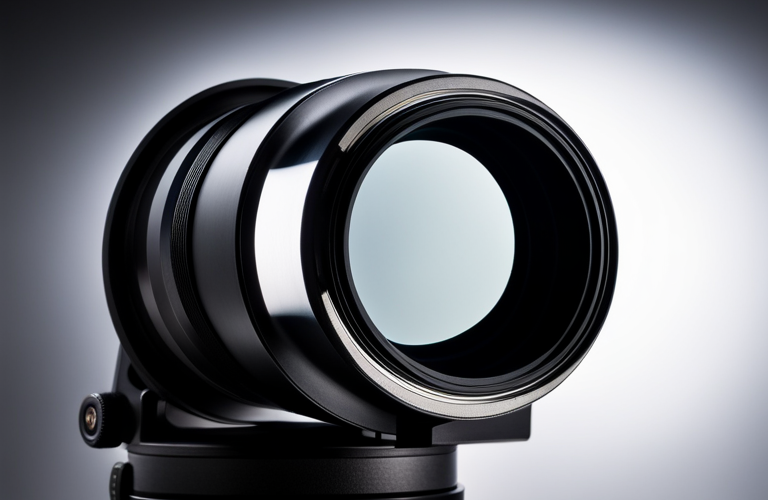Hey there stargazers and astronomy enthusiasts! Are you ready to embark on an adventure into the vastness of our universe? Well, before you blast off into the wonders of space, there's something important we need to discuss: the proper care and maintenance of your telescope lenses. Whether you're a seasoned astronomer or a newbie to the night sky, preserving the quality of your telescope lenses is essential for optimal performance. In this blog post, I'll be sharing some essential tips and tricks on how to preserve the clarity and functionality of your telescope lenses, so you can continue exploring the celestial wonders above. So, grab your telescope and let's get started on this lens-saving journey!
Table of Contents
Quick Answer
To preserve your telescope lenses for optimal performance, you should handle them with care and avoid touching the glass surfaces. Regularly clean the lenses using a soft cloth or brush, and never use harsh chemicals. Also, store them in a clean, dry place to prevent dust or moisture buildup.
How often should telescope lenses be cleaned?
Having owned and used telescopes for over three decades, I recommend that you only touch or clean your telescope lenses when needed. Touching or cleaning the lenses on a regular basis can actually increase the risk of scratches or damage. Only clean them if you notice a significant decrease in image quality due to dirt, dust, or fingerprints. When cleaning, be extremely cautious and use a soft, lint-free cloth or lens cleaning solution specifically designed for optics. Also, follow the manufacturer's guidelines or consult a professional if you're unsure. Remember, the key is to maintain the lenses' clarity while minimizing the potential for accidental damage.
What cleaning materials are best for preserving lenses?
The best cleaning materials for preserving lenses are microfiber cloths and lens cleaning solution. Microfiber cloths are gentle and won't scratch the lens surface. You can find them at any eyewear store or online. Lens cleaning solutions are specifically designed to remove fingerprints, smudges, and dirt without damaging the lens coating. Avoid using any household cleaners or paper towels as they can scratch the lens or leave residue. When cleaning, first use the cloth to gently remove any visible debris, then apply a small amount of lens cleaning solution and wipe in a circular motion. Remember to always treat your lenses with care to ensure longevity and clarity.
How can dust and dirt be prevented from accumulating on lenses?
To prevent dust and dirt from accumulating on your lenses, there are a few steps you can take. Firstly, always keep lens caps on when your camera or lenses are not in use. Additionally, try to avoid changing lenses in dusty environments. When cleaning, use a soft brush or blower to remove loose particles before using a microfiber cloth or lens cleaning solution to gently wipe the lens surface. Avoid using your breath to clean lenses as moisture can cause further issues. Keeping your lenses in a clean and sealed storage bag when not in use can also help prevent accumulation of dust and dirt.
What techniques can be used to safely handle lenses?
To safely handle lenses, there are a few techniques you should keep in mind. First, make sure your hands are clean and dry before touching the lens. Use a lens cleaning solution and a microfiber cloth to gently wipe the lens surface in a circular motion, avoiding any excessive pressure. When not in use, store the lens in a clean and dry case. Avoid leaving your lens in extreme temperatures or direct sunlight. Additionally, never leave your lens face down on a surface to avoid scratches. By following these techniques, you can ensure the longevity and quality of your lenses.
What techniques can be used to safely handle lenses?
What methods can be used to protect lenses from moisture?
A lens hood is one of the most effective ways to protect your lenses from moisture. This accessory not only blocks unwanted light but also acts as a barrier, keeping moisture away from the lens. Additionally, consider investing in a good lens pouch or case to protect your lenses while on the go. Ensure that your camera bag or storage area is dry and well-ventilated to prevent moisture buildup. Another handy tip is to avoid sudden temperature changes, as condensation can occur when you move between extreme environments. Lastly, always carry a microfiber cloth to wipe any moisture or condensation off the lens surface.
Final Words
Therefore, maintaining optimal performance and longevity requires preserving telescope lenses. You can keep your telescope lenses in good shape by following these essential maintenance tips, ensuring they are sharp and clear and that they will provide you with clear views of the night sky for years to come. Proper telescope maintenance and lens care, including regular lens cleaning, correct storage techniques, and lens protection, are crucial to prevent any damage or deterioration. By implementing these simple lens cleaning techniques and telescope maintenance tips, you can greatly improve the lifespan and performance of your telescope lenses. So, take care of your lenses, and they will always take care of you, providing you with breathtaking views of the universe for years to come.
FAQ
1. Why is it important to maintain telescope lenses?
Maintaining telescope lenses is crucial for optimal performance because they directly affect the quality of the images you capture. Any debris, fingerprints, or scratches on the lens surface can significantly degrade the clarity and sharpness of the images.
2. How often should I clean my telescope lenses?
The frequency of lens cleaning will depend on various factors such as your observing environment and usage frequency. As a general guideline, it is recommended to clean your telescope lenses at least once every couple of months. However, if you notice any visible dirt or smudges, it is advisable to clean them immediately.
3. What should I use to clean telescope lenses?
When cleaning telescope lenses, it is crucial to use the right tools and materials to avoid damage. A soft camel-hair brush or a dedicated lens-cleaning brush can be used to gently remove loose dust particles. To remove fingerprints and smudges, use a specialized lens cleaning solution and a microfiber cloth. Avoid using regular tissues, paper towels, or any harsh cleaning chemicals as they can scratch or damage the lens coatings.
4. How should I clean the lenses?
Start by using a soft brush to remove any loose dirt particles from the lens surface. Next, apply a small amount of the lens cleaning solution on the microfiber cloth and gently wipe the lenses in a circular motion. Be careful not to apply excessive pressure or rub too vigorously, as this can cause scratches. Finally, use a dry portion of the microfiber cloth to wipe away any residue.
5. Can I use compressed air to clean my telescope lenses?
It is generally not recommended to use compressed air to clean telescope lenses. While it may remove loose dust particles, there is a risk of blowing particles onto the lens surface or pushing them deeper into the lens elements. Additionally, the force of compressed air can potentially damage the delicate lens coatings.
6. How do I protect my telescope lenses when not in use?
When your telescope is not in use, it is crucial to store it properly to minimize the risk of lens damage. Always replace the lens caps to prevent dust, moisture, or accidental contact. Additionally, consider investing in a protective case or bag to store your telescope, providing an extra layer of safeguarding.
7. Should I clean the lenses if I see minor specks of dust?
Minor specks of dust on the lens surface generally do not impact image quality significantly. Attempting to clean the lenses for such minor dust particles may pose a greater risk of introducing scratches or damage. It is generally recommended to clean only when the dirt or smudges are noticeable and affecting the image quality.
8. Can I use lens cleaning wipes or eyeglass cleaner for my telescope lenses?
Lens cleaning wipes designed specifically for camera lenses or eyeglass cleaner labeled safe for lens coatings can be used for cleaning telescope lenses. However, make sure to read the instructions carefully and avoid any products containing alcohol or abrasive chemicals, as they can damage the lens coatings.
9. Can I use my breath to clean the lenses?
It is not advisable to use your breath to clean telescope lenses. While the moisture from your breath can help remove slight smudges, it can also contain microscopic particles and oils that can leave residue and potentially harm the lenses. It is safer to use a dedicated lens cleaning solution and a microfiber cloth.
10. What should I do if I accidentally scratch my telescope lens?
If you accidentally scratch your telescope lens, it is essential not to panic. Minor scratches may have minimal impact on image quality. However, deep or extensive scratches can significantly affect the performance. In such cases, it is recommended to consult a professional for repair or replacement options. Avoid attempts at home remedies, as they may further worsen the damage.










Add comment